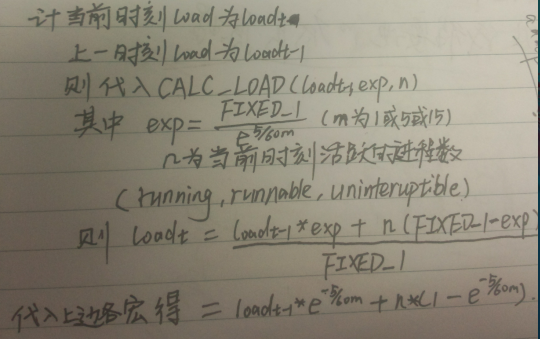load average
基本含义
man uptime
DESCRIPTION
...
System load averages is the average number of processes that are either in a runnable or uninterruptable state. A process in a
runnable state is either using the CPU or waiting to use the CPU. A process in uninterruptable state is waiting for some I/O
access, eg waiting for disk. The averages are taken over the three time intervals. Load averages are not normalized for the number
of CPUs in a system, so a load average of 1 means a single CPU system is loaded all the time while on a 4 CPU system it means it was
idle 75% of the time. 翻译:
系统负载均值是一个可运行状态和不可中断状态的进程的平均值。可运行状态包含运行着占着cpu的,还有在进程队列中等待着的去占cpu的,还有处于不可中断状态的(为什么叫不可中断状态?)如等待磁盘的。
负载均值有三个时间间隔,1分,5分,15分。负载均值为1在单个cpu的机器上负载满了,但是在4个cpu的表明其在75%的时间内是空闲的。
计算
那么均值是如何均的呢?
#define FSHIFT 11 /* nr of bits of precision */
#define FIXED_1 (1<<FSHIFT) /* 1.0 as fixed-point */
#define LOAD_FREQ (5*HZ) /* 5 sec intervals */
#define EXP_1 1884 /* 1/exp(5sec/1min) as fixed-point */
#define EXP_5 2014 /* 1/exp(5sec/5min) */
#define EXP_15 2037 /* 1/exp(5sec/15min) */
#define CALC_LOAD(load,exp,n) \
load *= exp; \
load += n*(FIXED_1-exp); \
load >>= FSHIFT;
unsigned long avenrun[3];
static inline void calc_load(unsigned long ticks)
{
unsigned long active_tasks; /* fixed-point */
static int count = LOAD_FREQ;
count -= ticks;
if (count < 0) {
count += LOAD_FREQ;
active_tasks = count_active_tasks();
CALC_LOAD(avenrun[0], EXP_1, active_tasks);
CALC_LOAD(avenrun[1], EXP_5, active_tasks);
CALC_LOAD(avenrun[2], EXP_15, active_tasks);
}
}
在linux系统上,负载均值不是每个时钟周期tick都计算的,但是会被一个基于Hz频度设置的变量值触发,也就是调用上边的calc_load函数中if(count < 0)中的代码块(这个值是可以设置的,是linux内核活动的心率,默认情况下1Hz等于1tick,也就是10ms)。虽然Hz的值在某些内核版本中是可配,不过它通常被设为100(就是一秒啦,这里的Hz给我们高中学的频率的单位好像不一样哎),通过这个值来计算内核负载的计算频度。一般情况是每5Hz触发一次这个算法
(每个时钟周期都检测调用calc_load函数,但是5s才触发一次计算CALC_LOAD)
1 HZ = 100 ticks
5 HZ = 500 ticks
1 tick = 10 milliseconds
500 ticks = 5000 milliseconds (or 5 seconds)
So, 5 HZ means that CALC_LOAD is called every 5 seconds.
每个时钟周期都调用一下calc_load方法。LOAD_FREQ是个宏,值为5Hz,count初始值为LOAD_FREQ,没调用一次calc_load,其值减少1ticks,当其减少到小于0时候,触发CALC_LOAD中算法,计算load值,其中avenrun数组分别保存系统当前1分,5分,15分的负载均值。
active_tasks的计算源码,即使遍历tasklist的链表,累加所有task状态为running的,runnable的和uninterruptible的进程的个数。
/* Nr of active tasks - counted in fixed-point numbers */ static unsigned long count_active_tasks (void) { struct task struct *p; unsigned long nr = 0;
read_lock (&tasklist_lock);
for_each_task(p) {
if ( (p->state == TASK_RUNNING ||
(p->state & TASK_UNINTERRUPTIBLE ) ) )
nr += FIXED_1;
}
read_unlock(&tasklist_lock);
return nr; }
下边是推导的CALC_LOAD的函数,至于exp为什么要那么计算,其数学背景是什么,等我知道了再补上。

结论
load_m = load_m * exp(-5 / 60m) + n * (1 – exp(-5 / 60m))
其中m为1或5或15
注:外链二中源码有误(第10页代码631行)
参考文献
load维基百科
http://www.teamquest.com/import/pdfs/whitepaper/ldavg1.pdf
http://www.gracecode.com/posts/2973.html
http://www.penglixun.com/tech/system/how_to_calc_load_cpu.html

